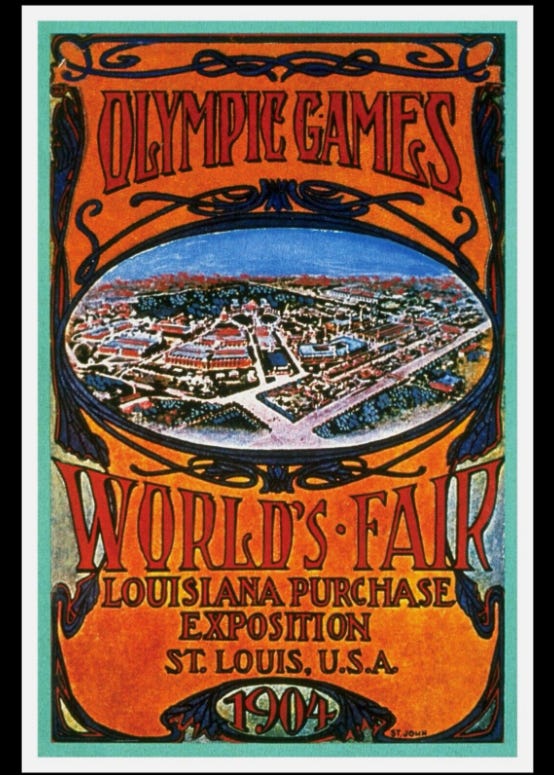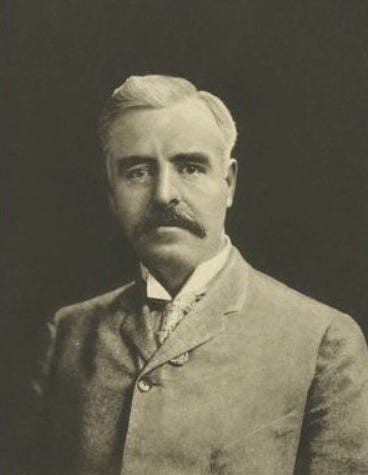St Louis Olympics 1904: The Jim Crow Games
Olympiad III featured the first Black American Olympic medalist but also racially segregated events.
The World’s Fair
St Louis would win the rights to host Olympiad III in 1904 in conjunction with the World’s Fair celebrating the purchase of the Louisiana Territory from France. Olympic events would be staged as a result over five months. Only 12 nations were represented and just 62 athletes came from outside North America.
George Poage: America’s First Black Olympic Medalist
There was not much fanfare when George Poage traveled to the 1904 Olympic Games in St. Louis. At the University of Wisconsin Poage had been the first Black athlete to win a race in the Big Ten Conference track championships. He would later graduate with a degree in history.
Several top Black athletes had chosen not to participate in the games. American civil rights leaders urged Black athletes to boycott the Olympics because fans attending events would be segregated. Poage, though, seemed to feel it would make a bigger statement to participate, competing in four events.
While he did not medal in the 60-meter dash or the 400-meter run, Poage placed third in both the 200-meter hurdles and 400-meter hurdles, winning two bronze medals, becoming the first Black American Olympic medalist.
Anthropology Days
Important to the study of race and racism in America at that time may be the so-called Anthropology Days. These were a series of events open to minority, aboriginal, or native people from various lands who were present at the Physical Culture exhibits of the Louisiana Purchase Exposition. Among the tribes that competed were Pygmies, Patagonians, Filipinos, Native American Indian tribes, Japanese Ainus, and certain Asian tribes. The events included throwing bolos, mud fighting, and climbing a greased pole.
James E. Sullivan: 1904 Games Organizer
James E. Sullivan, the organizer of the Anthropology Days maintained that it would have scientific value for years to come. “The whole meeting proves conclusively that the savage has been a very much overrated man from an athletic point of view,” he wrote.
Sullivan was an original founder of the Amateur Athletic Union in 1888, long-time editor of Spalding’s Athletic Almanacs, organizer of the 1904 Olympics and, for years, the dominant force in American amateur athletics. Eight years later he also would come to play a crucial role in taking back the Olympic gold medals won by American Indian Jim Thorpe, a natural athlete if ever there was one.
In reading Sullivan’s rationale for the Anthropology Days, it is apparent that this was intended to be a scientific study of the athletic abilities of the “savages.” Interestingly, one of the spectators for the contests was the Apache chief Geronimo (1829–1909).
In addition to the so-called aboriginal events described above, several standard athletics events were contested: 100-yard run, shot put, 440-yard run, broad jump, high-hurdle race, one-mile run, and the weight throw event.

In most cases, the events were separated into heats, or perhaps one could more accurately say, segregated. As an example, in the 100-yard run there were sections for Africans, Lanao Moros (Filipinos), Patagonians, Asians (Syrians from Beirut), Native Americans of the Cocopah tribe, and Native American Sioux. There were no finals, in which the winners of the heats would have competed against each other.
The results were the opposite of the rumored superb athletic abilities of the various tribes. In fact, the athletes performed very poorly. In most cases, this was attributed to the fact that the events were strange and unnatural to them, and not ones that they usually practiced.
Some of the observers objected that the results would have been better if the participants had some training, or even concern for the outcome. “It was a very hard situation to handle,” said the report. And one important figure found the whole affair appalling.
Pierre de Coubertin, the founder of the modern Olympic movement, called it “an outrageous charade.”
“It will of course lose its appeal,” he wrote, “when black men, red men and yellow men learn to run, jump and throw, and leave the white men behind them.”
Debuts and Firsts
The 1904 Olympic Games were the first at which gold, silver and bronze medals were awarded for first, second and third place. Boxing, freestyle wrestling, decathlon and a dumbbells event all made their debuts on the program.
Memorable Champions
One of the most remarkable athletes of the 1904 games was the American gymnast George Eyser, who won six (6) medals even though his left leg was made of wood. Eyser was a German-American gymnast competed with a prosthesis for a left leg, having lost the leg after being run over by a train. Despite his disability, he won a gold in the vault, an event which then included a jump over a long horse without the aid of a springboard!
Thus in many ways, the 1904 Olympic Games are important to the early study of race and racism at the Olympic Games.
They saw the first American black athlete win a medal. They saw the first South African competitors who, pre-dating the days of apartheid, were also black men. But most importantly, they were the only Olympic Games at which aboriginal and native peoples were paraded about on exhibition and exposed to ridicule under the guise of a scientific study.










